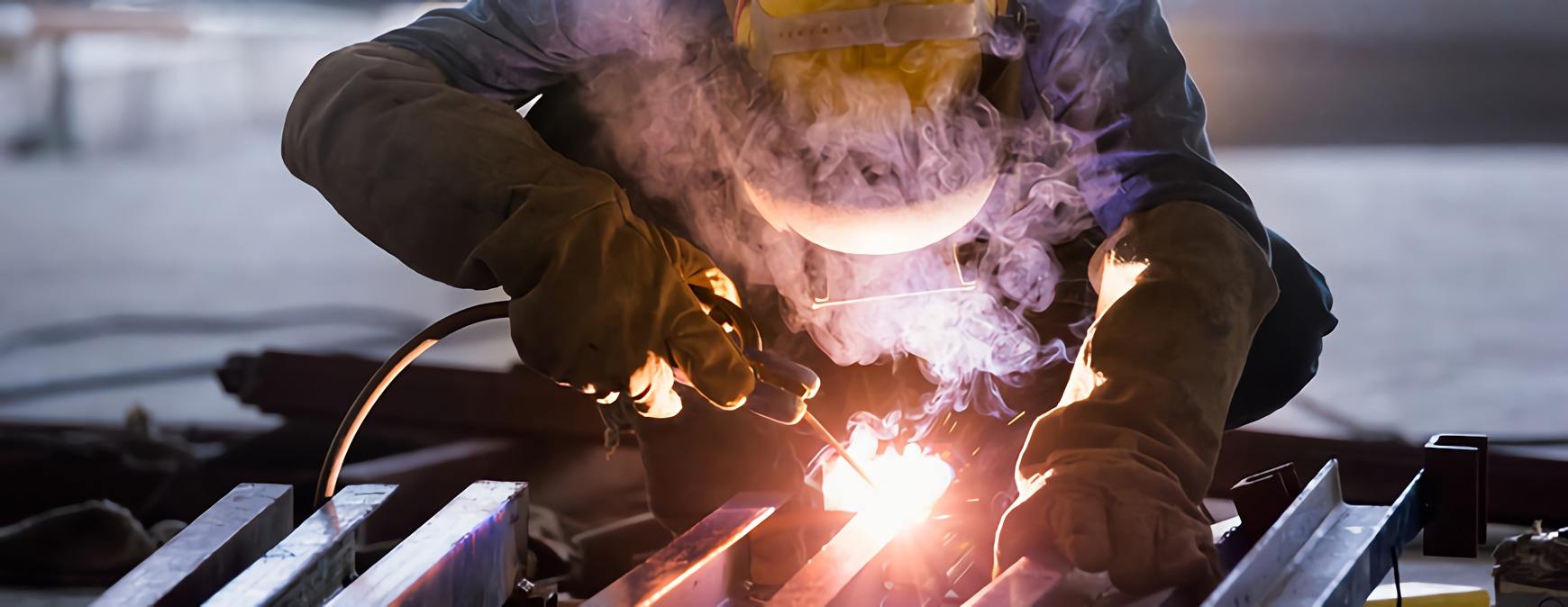
A method of fusing metals with heat or pressure, welding is a diverse technology with numerous applications. One reason for this is that there are so many different types of welding processes: welders have at least 67 to choose from! 1 Read on to learn about some of the most popular welding processes and their applications.
Shielded Metal Arc Welding (SMAW)
Shielded metal arc welding (SMAW) uses a flux-coated electrode to conduct the welding current from the electrode holder to the metals being welded. The electrode has two purposes: as the arc melts the flux, it vaporizes into a shielding gas that protects the weld from contamination; the arc also melts the electrode and it becomes part of the weld, making it stronger.
Since SMAW uses relatively basic equipment and a wide variety of filler metals, it can be used on many types of metals of varying thicknesses. 2 The simplicity and versatility of SMAW makes it one of the most common processes. 3 Shipbuilding, pressure vessel fabrication, and repair work are some of the most popular uses of SMAW. 4
Gas Tungsten Arc Welding (GTAW)
Unlike SMAW, the electrode used in gas tungsten arc welding (GTAW) is non-consumable, meaning it does not become part of the finished weld. Instead, an arc is formed between the electrode and the base metal. A shielding gas is used to protect the work from contamination while the welder feeds a thin wire of filler metal into a weld pool that has formed at the base metal. GTAW requires a high level of skill and produces clean, precise welds.
GTAW was developed in the 1930s and 1940s by the aircraft industry. 5 Today it is still employed in the construction of airplanes, as well as other transportation sectors. The precision of GTAW works well with the aluminum and exotic alloys that are being used to reduce the weight and fuel consumption of planes, cars, and other types of vehicles. 6 This is also why GTAW is used to build racecars. Nearly 95 percent of NASCAR racecars are welded by hand using the GTAW process. 7 GTAW is also used in the construction of pipes for the petroleum, steam, and chemical industries. 8
Get Started on the Path to a New Career
Fill out our form to learn how we can help you change your life.
Gas Metal Arc Welding (GMAW)
Although metal arc welding utilizing a wire has been in use since the 1920s, it was not until 1948 that an inert shielding gas was introduced to the process. While gas metal arc welding (GMAW) can be performed as a semiautomatic process or fully automated, it is usually semiautomatic. 9 During the process, a solid electrode wire is continuously fed through a gun, carrying the welding power to the base metal, where the wire and base metal melt. At the same time, the gun emits a shielding gas through a separate cartridge.
GMAW is a quick and economical process that requires minimal cleanup. It can be used on metals of varying degrees of thickness. 10 For this reason it is widely used in the manufacturing industry. 11 On a daily basis, it’s likely you use something GMAW helped produce: home appliances, automobiles, furnaces, air conditioners, and much, much more. 12 In fact, more than half of the goods made in the U.S. rely on welding. 13
Additional Welding Applications
SMAW, GTAW, and GMAW are the most common but not the only welding processes. There are resistance welding, high energy beam welding, oxyfuel gas welding, and other processes with their own applications. 14 Applications not discussed in this article include trains, cruise ships, sculptures, spacecraft, and roller coasters. 15 As you can see, individuals with a welding education and experience play a pivotal role in making the structures and products we use daily possible.
Additional Sources
1 – Title: Welding Principles and Applications; Author: Larry Jeffus; Delmar Cengage Learning; Seventh Edition; Textbook page 5-9
2 – Title: Welding Principles and Applications; Author: Larry Jeffus; Delmar Cengage Learning; Seventh Edition; Textbook page 8
3 – http://www.thefabricator.com/glossary/shielded-metal-arc-welding-smaw
4 – http://www.yourarticlelibrary.com/metallurgy/arc-welding/shielded-metal-arc-welding-smaw-equipment-and-applications/96604/
5 – Title: Welding Principles and Applications; Author: Larry Jeffus; Delmar Cengage Learning; Seventh Edition; Textbook page 374
6 – http://weldingdesign.com/processes/applications-tig-welding-growing
7 – http://www.nascar.com/en_us/news-media/articles/2013/mobil-1-technology-hub/nascar-mobil-1-welding-stewart-haas-racing-daniel-smith.html
8 – https://me-mechanicalengineering.com/gas-tungsten-arc-welding-gtaw/
9 – Title: Welding Principles and Applications; Author: Larry Jeffus; Delmar Cengage Learning; Seventh Edition; Textbook page 234
10 – Title: Welding Principles and Applications; Author: Larry Jeffus; Delmar Cengage Learning; Seventh Edition; Textbook page 9-10
11 – https://www.slideshare.net/SchamaltzyShahin/application-of-tig-mig-welding-in-manufacturing
12 – Title: Welding Principles and Applications; Author: Larry Jeffus; Delmar Cengage Learning; Seventh Edition; Textbook page 6
13 – http://www.careersinwelding.com/welding_fun_facts.php
14 – Title: Welding Principles and Applications; Author: Larry Jeffus; Delmar Cengage Learning; Seventh Edition; Textbook page 9
15 – Title: Welding Principles and Applications; Author: Larry Jeffus; Delmar Cengage Learning; Seventh Edition; Textbook page 6
This blog has been labeled as archived as it may no longer contain the most up-to-date data. For a list of all current blog posts, please visit our blog homepage at https://www.rsi.edu/blog/

